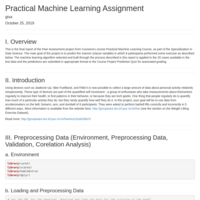Recently Published

Consumption vs Transmission - Regression Model Building
In this project, based on the *mtcars* dataset (from the 1974 Motor Trend US magazine) we are interested in the comprehension of the relationships between dataset's cars' fuel consumption and a set of variables, trying, in particular, to model and quantify the one between the consumption and the car's transimission type.

NLP_Next-Word_Prediction_Algorithm_App_Presentation
Building a predictive model of English text that will support a next-word prediction application.

NLP - Next-Word Prediction Language Model: Milestone Report
Coursera Data Science with R Capstone: Milestone Report
This is the Milestone Report of our project (collaboration: Coursera + Swiftkey) to create a predictive text model using a large corpus of documents as training data. Based on NLP techniques, our language model built its understanding of the English language from 3 different corpora: a list of blog posts, a list of news articles, and a list of tweets.

Iris Shiny App Presentation
an interactive tool that, based on the iris dataset, would be able to predict the width of the sepals/petals given their corresponding length

World Temperature last 150 years (Plotly)
The following illustrates the change in global surface temperature relative to 1951-1980 average temperatures.

My Google Maps saved places ( - 22/01/2020)
Leaflet basic application

Practical Machine Learning Assignment
This is the final report from Coursera’s course Practical Machine Learning Course, as part of the Specialization in Data Science.
The main goal of the project is to predict the manner (classe variable) in which 6 participants performed some exercise as described below. The machine learning algorithm selected and built through the process described in this report i Decision Tree (RPART), Linear Discriminant Analysis (LDA), Gradient Boosting Machne (GBM), Random Forest (RF) Support Vector Machine (SVM) with or without Model Stacking, with or without Dimensionality Reduction (with Principal Component Analysis (PCA) or Near-Zero Variance Predictors Filtering)

Economic and health impact of severe weather events in the USA (1950-2011)
This brief report is examining the most damaging types of weather events in terms of fatalities and economic impact throughout the USA from 1950 to 2011. Severe weather events can cause both public health and economic problems for communities and municipalities. Many severe events can result in fatalities, injuries, and property damage, and preventing such outcomes to the extent possible is a key concern. This project involves exploring the U.S. National Oceanic and Atmospheric Administration’s (NOAA) storm database. This database tracks characteristics of major storms and weather events in the United States, including when and where they occur, as well as estimates of any fatalities, injuries, and property damage.

